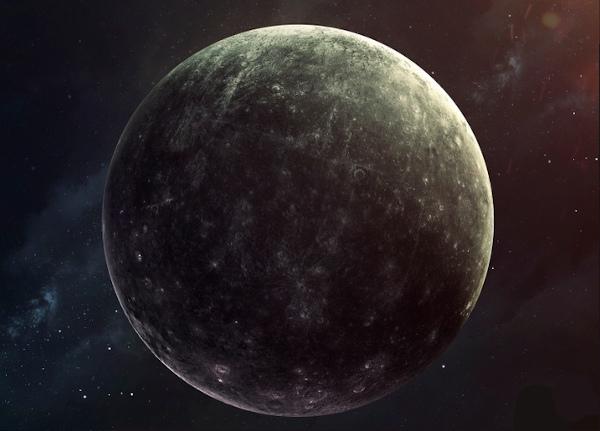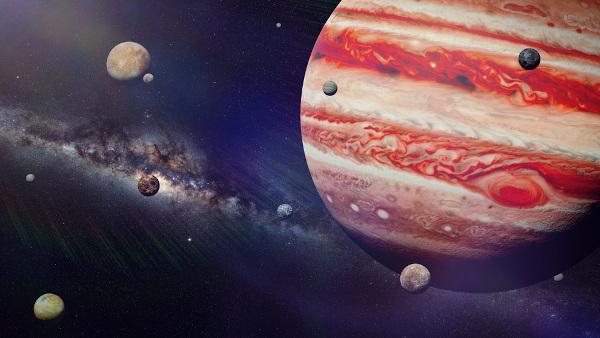Mercury is considered the smallest planet in the Solar System since the downgrade of Pluto the dwarf planet. The proximity of Mercury to the Sun (it is the closest planet to this star) makes the development of life on this planet very difficult, as there are high and low temperatures, climatic instabilities, weak atmosphere and a dark surface, perhaps due to the presence of graphite or even the high temperatures, which “carbonize” the landscapes.
Despite all the odds, it is an intriguing planet and one that catches the attention of astronomers for containing water, both solid and liquid (in smaller amounts).
Read too: Why don't we feel the Earth rotate?

General Mercury Data
Equatorial Diameter:4,879 kilometers.
Surface area:7.5 x 107 km².
Pasta:3.302×1023 kg (330 billion billion tons).
distance from the sun:57,910,000 kilometers.
Natural satellite: does not have.
rotation period:approximately 59 days.
translation period:approximately 88 days.
Average temperature: Due to the high thermal variation, the planet has an average temperature of 179 ºC.
atmospheric composition:because it is so close to the sun, Mercury's atmosphere is quite unstable and weak, compared to that of Earth. In general, it has gases such as helium, sodium and oxygen, with a predominance of the first two.
Do not stop now... There's more after the advertising ;)
Mercury Characteristics
Thanks to the two space probes that have visited Mercury in recent decades (Mariner, in the 1970s, and Messenger, in 2011), a lot is already known about Mercury, but there is still a lot to explain and several unanswered questions, many with assumptions and estimates. Such a mystery is perfectly acceptable, given the difficulty of accessing the planet, which has climatic instability, low and high temperatures and a peculiar orbit.
Mercury's orbit, for example, is one of the least circular in the Solar system. During perihelion, the planet reaches a distance of 47 million kilometers from the Sun. In aphelio, this distance reaches 70 million kilometers.

Mercury is a planet that does not have an Earth-like inclination. Without this inclination and with a short translation, there are no seasons. This low slope also explains the ice found in the craters on this planet. According to studies by the Messenger spacecraft, the fact that it is not well tilted in relation to the Sun means that the lighting does not reach the bottom of the craters, allowing the formation of ice at night.
Your atmospheric composition is unstable and weak when compared to ours. The proximity to the Sun causes Mercury to suffer from the solar winds, making it difficult for the atmosphere, natural satellites and rings to be present. Thereby, the planet is susceptible to meteors, which constantly crash into the planet, opening huge craters.
Mercury's physical structure also attracts attention. The probe studies indicate that the planet's core is larger than Earth's, corresponding to 75% of Mercury. This is quite disproportionate, considering that it is the smallest planet in the Solar System, but with a core of almost 4000 kilometers in diameter.
One possible explanation is that Mercury was a huge planet, located far away from where it is today, billions of years ago. With its orbital movement, it was transported closer to the Sun. During this “transport”, collisions with other celestial bodies affected its structure, reducing its rock mass. This turbulent past can also help explain the density of Mercury, which is the second densest planet in the solar system, second only to Earth.
In 2018, a third space probe set out in search of more answers about Mercury, the BepiColombo probe, whose partnership was between the European space agency ESA and the Japanese agency JAXA. The expectation is to get to know even more the smallest planet in the Solar System.
Read too: Why hasn't man returned to the moon yet?
Mercury in culture
The planet's name is related to Greek and Roman mythological cultures. According to these two peoples, Hermes (to the Greeks) and Mercury (to the Romans) are considered the messenger gods, acting quickly in communication between peoples.
As its orbit reaches up to 180 thousand km/hour, the planet received this name, as it has a very fast movement in the Universe.
In astrology, Mercury is considered the planet of the sign of Gemini, which is linked, in turn, to communication and intelligence, something typical of a messenger god.
In the names of the days of the week, Wednesday is a day dedicated to the planet. For the Romans and Greeks, this was the day of the messenger god. On that day, commercial activities and travel are facilitated in the mythological belief, hence the name Miercoles (in spanish) or mercoledì (in Italian). Both names mean "Day of Mercury".
Curiosities about Mercury
Its name derives from the god Mercury, the messenger god of Roman mythology.
The first telescope observations date back to 1610, and Galileo Galilei made the first findings.
A day on Mercury lasts 59 days on Earth.
A year on Mercury lasts 88 days on Earth.
Mercury's rotational speed can reach 180,000 km/hour.
Even though it was close to the Sun, space probes found ice on Mercury.
Temperatures on the planet can reach a maximum of 420 ºC and a minimum of -173 ºC, making it the planet with the largest thermal oscillation in the Solar System.
Due to its weak atmosphere, Mercury is very susceptible to collisions with meteors, meteorites and comets. As such, it is the planet with the highest number of craters among the eight in the Solar System.
Throughout space history, three probes have visited Mercury: Mariner 10 in 1975; Messenger, in 2004; and BepiColombo, in 2018. The years cited were the years when the probes left Earth.
The planet's core occupies 75% of its entire mass.
A trip from Earth to Mercury would take, on average, 7 years.
There is no evidence of plate tectonics on Mercury.
See too: 8 fun facts about the Solar System
solved exercises
question 1 – (UEPG 2010 - adapted) About the Solar System, its component stars and the movements of these stars, tick V for what is true and F for what is false.
I – ( ) The more distant planets from the Sun, the faster they describe their translation movement, while those closer to the Sun, the more slowly describe their orbits.
II – ( ) All planets in the Solar System have rotation movements, and some rotate a lot slowly around its axis, like Jupiter, and others rotate quickly, like Venus. They all practice rotating in the same direction, from west to east.
III – ( ) Jupiter, Saturn, Uranus and Neptune are the giant planets of the system and have a gaseous constitution. They are considered outer planets, as they orbit the Sun beyond the asteroid belt.
IV – ( ) Pluto is no longer considered one of the nine planets that make up the Solar System and is now a dwarf planet.
V – ( ) Mercury, Venus, Earth and Mars are solid, rocky planets and, therefore, called terrestrial planets. They are also considered interior planets, as their orbits are located below the asteroid belt.
The correct order, from top to bottom, is:
A) F F V V V
B) F V F V V
C) V V F F V
D) V F V F F
Resolution
Alternative A.
I – F – The further away from the Sun, the longer it takes a planet to complete its translation.
II – F – Not all planets rotate in the same direction as Earth. Venus, for example, rotates in reverse.
III – V
IV – V
V – V
Question 2 - In the Universe, many planets have natural satellites that rotate around them, that is, that orbit them. This is the case of planet Earth, which has the Moon as a natural satellite. Among the planets in the Solar System, those that do not have natural satellites rotating around them are:
A) Venus and Mars.
B) Uranus and Neptune.
C) Mercury and Venus.
D) Mercury and Neptune.
Resolution
Alternative C. Because they are closer to the Sun, Mercury and Venus do not have natural satellites due to solar storms, which prevent the orbital presence of these celestial bodies.
By Attila Matthias
Geography teacher


